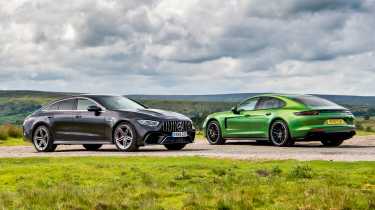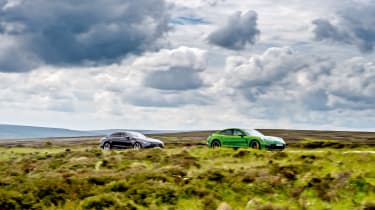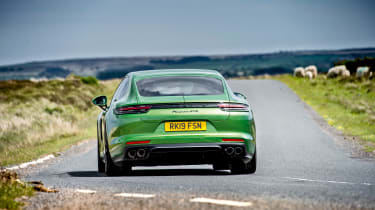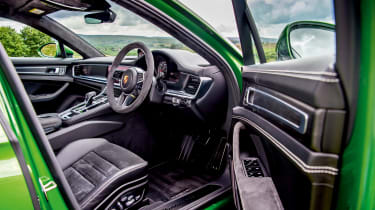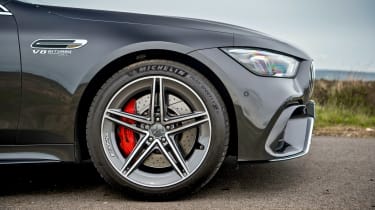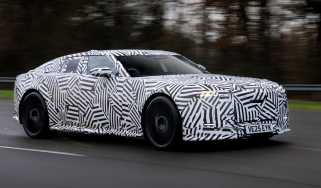Porsche Panamera GTS v Mercedes-AMG GT63 4-Door Coupé
They’re from the lower end of the four-door supercoupe spectrum, but do the ‘basic’ 577bhp Mercedes‑AMG GT63 4-Door and less powerful but still spicy Porsche Panamera GTS still cut it?
Rare is the occasion a turbocharged Porsche feels a bit gutless. 991 GT2 RS? Not short of ‘go’, is it? Any 911 Turbo for that matter – they tend to feel even faster than the numbers on the tin suggest, always have done. Even Porsche’s current entry-level car, the much-derided 2-litre 718, makes a healthy, turbocharged 296bhp and feels good for every last Pferdestärke.
And yet, right at this moment, the 4-litre twin-turbo V8 in the Panamera GTS I’m driving feels if not limp, then certainly subdued. That’s a bizarre comment to make about a 454bhp superlimo, I’m well aware of that, but the shapely, streamliner rear of the Mercedes-AMG GT63 4-Door ahead is marching away from us every time the road runs straight and there’s absolutely nothing I can do about it but listen. In fact, I can almost sense the low-frequency jackhammering from its quad firecracker exhausts permeating the Porsche’s windscreen and passing right through me. In a comparison of V8s, eastern Stuttgart has clearly put one over the northern suburbs in this derby game.
> Porsche Panamera review – verdict, specs and prices
They’re a strange pair, these two. For starters, they’re luxury supersaloons for those who don’t want a supersaloon and are willing to compromise on a little headroom here, some luggage room there – and pay extra for the inconvenience. In return, both seek to inject a greater dose of style, individuality and dynamic ability into a small sub-niche of the genre, but in markedly different ways. Unlikely as it may sound, they’re also the lesser rungs in their respective model ranges, despite packing seriously powerful V8s under their long bonnets. Take the GT63, for example, which has – or I should say ‘had’, given you can no longer order one – a retail price of £121,350 compared to £140,535 for the still-available GT63 S, and offers ‘just’ the 577bhp compared to its bigger brother’s 630bhp, along with a slightly lower specification across the board (no dynamic engine mounts or electronic control of the rear differential, to mention just a couple of items).
Yet for the majority of buyers in this market, who may in all likelihood be leasing the car anyway, or buying with a finance PCP, the obvious temptation is simply to go for the ultimate. That’s why the regular GT63 has often seemed a bit superfluous, and also partly why Mercedes has decided to no longer make it, offering from now on just S and S Plus versions (yes, they still can’t resist a good old model hierarchy). The macro picture is that Mercedes-Benz, along with the other German premium manufacturers, has finally realised the madness of offering so many different models, and then sub-models within those ranges, and for reasons of cost and the associated WLTP emissions minefield is currently culling product plans left, right and centre. So the upshot is, while you can no longer order a GT63, you can still buy one from stock – and in the process expect a very large discount running to five figures. Until the end of June (and as long as it’s registered by the end of September) Mercedes is offering an immediate £10,000 off the 577bhp car, and what’s the likelihood of more cash heading back your way should you walk in through a dealership’s door? And that’s even before the effects of Covid-19 on the motor retail sector have been taken into account. So it may be a relative bargain, but the question is: should you snap one up?
Well, before we attempt to answer that question, let’s just give the big green Porsche an intro of its own. As is its maker’s modern inclination, this really is a niche within a niche, created here to ‘bridge the gap’, in the company’s own words, between the 434bhp V6-powered Panamera 4S (£92,443) and the 542bhp Panamera Turbo (£117,918). To do so Porsche has simply turned down the 4-litre twin-turbo V8 so that it produces 454bhp, with 457lb ft of torque (the Turbo makes 568lb ft), and charges £107,179 in return. This may seem like ludicrous levels of hair splitting, but to be fair to Porsche, the GTS recipe is a little more than just an obscure halfway house: as with the 911 and mid-engined GTS models, the overall idea is a grouping of a car’s sportiest options applied to a cheaper, less powerful variant in the range. A value sporting choice, if you were. With the Merc’s discounts there’s even a parity between our two contenders on price, if not power, but then as hard as we try to structure these two cars’ differences it’s all thrown into disarray by the fact this Mamba Green Panamera would retail at £131,672 with the options fitted and the GT63’s data sheet suggests it would land at £130,475. Hey ho. Game on.
The GT63 attempts to mislead from the start, because unlike the inference of the name, the AMG GT 4-Door Coupé has very little to do with the sleek AMG GT (coupe) and very much to do with the E63 saloon. However, that’s not to undermine the work that Affalterbach has carried out, which includes incorporating aluminium and carbonfibre into parts of the car’s structure to save weight and strengthen the body. Sadly, that hard graft hasn’t really paid off on the scales, because the GT63 still perches greedily upon them at an awkward 2025kg, but then part of this has to be down to the bewildering array of tech and luxury kit it’s stuffed with.
The Panamera GTS weighs 1995kg, giving a slight edge over the AMG, but it’s still hardly what could be termed a lightweight. Nevertheless, as those first few yards away from civilisation have proved – whereupon these big bruisers can finally stretch their legs – when it comes to straight-line acceleration the GT63 easily wins the battle of the 4-litre twin-turbo V8s, as the numbers suggest (the AMG claims 0-62mph in 3.4sec, while the GTS needs 4.1).
There’s nothing fundamentally wrong with the Panamera’s V8. Enjoyed in isolation it’s as smooth and polished in its manners as the pebbles on Aldeburgh beach, and any engine that can propel two tons to 62mph in four seconds is clearly a formidable powerhouse, but somehow, perceptibly so, it just lacks the sparkle we’ve come to expect from a turbocharged Porsche V8. It’s as if, er… it’s running a particularly tame ECU map. Funny, that.
Jump into the big Merc and the engine is the car. This M177 unit makes a mockery of the word ‘detuned’, bellowing a V8 soundtrack that sounds better than those of the majority of naturally aspirated V8s, and throwing the 4-Door down the road at a pace that would be considered socially obscene in most circles. Quite why anyone could ever feel the need for the S model’s 630bhp is inexplicable, but in this crazy, numbers-obsessed era we live in that is indeed now the only choice GT63 buyers are going to have.
It’s the AMG’s 590lb ft that really does the damage to the Porsche. That extra 133lb ft gives the 63 a huge margin of superiority in real-world driving situations. Consider that the Panamera Turbo offers less at 568lb ft, and you’ll need to opt for the hybrid-powered Panamera Turbo S with its massive combined 627lb ft (and obesity) before the AMG is overwhelmed on twisting force.
What’s an amusingly green Panamera to do in such circumstances? Pray for corners, that’s what. Both of these cars feature air suspension, adaptive damping and four-wheel drive, but their approach to chassis dynamics is markedly different.
The clues are there from the start. As soon as posterior is in contact with seat squab in the Porsche it’s obvious the driving position is much more sports car than saloon car. The broad centre console is high set, running like a spine through the car, and consequently you’re sitting very much ‘in’ the Panamera rather than ‘on’ it, as you are in the GT63. The upshot is that from the moment you ask for a sudden direction change in the GTS, it delivers, shrinking in size and feeling much lighter than in reality it is. The AMG does its best to pull off the same trick, but physics won’t be denied so easily. It steers with an immediacy that takes a little getting used to, there being very little dead zone around the straight-ahead, a quick ratio thereafter and a notable self-centring effect. This promotes a sense of agility, but that’s only true up to a set level of commitment; push harder, and things get a little more ragged…
Having played second fiddle to the Merc for most of the morning, once we’re on the wide open spaces of the North York Moors the Panamera smells revenge. With massive, optional carbon-ceramic discs it brakes with a fanaticism for shedding speed that throws you deep into the restraint of the belt, the gears clicking down rapidly in the eight-ratio PDK ’box. If only the paddles were larger and more satisfying to use, but it’s still a superior driver’s transmission to the less mechanical-feeling, less sporting nine-speed MCT automatic in the AMG. The Panamera’s helm feels calmer, with that typical progressiveness so redolent of a Porsche. You have to learn the Merc’s steering and adapt your driving style accordingly, but from the moment you first turn the wheel in the Porsche you never even question it, which is perhaps the biggest compliment you can pay it.
Flick the GTS into the turn and it scythes towards the apex, then adopts a pleasing and effective blend of neutrality and traction on the way out. We’re through that corner, then the next, and constantly stretching the gap with the GT63 behind, which can’t bring enough of its firepower to bear to reverse the situation by more than the odd yard here and there. For such a big machine the GTS is keen as one of the local-bred terriers to get on with things, particularly if you’ve progressed damper and throttle map settings in a warmer direction.
The Merc feels its weight, but it is more prepared to have a party while it’s being left behind. The standard GT63 doesn’t have the electronic front axle delete mode of the S, but even with all four wheels ostensibly receiving torque it will wag its tail under acceleration, post apex. That’s just not something that happens in the Panamera, whether because it lacks the near-600lb ft to get the rear tyres spinning up or because its four-wheel-drive system just isn’t so playful. It’s not long before a great divide opens up between what seemed like close rivals. The Panamera an athlete on a diet of protein shakes and root veg, the AMG a powerlifter that loves a beer or two at the weekend.
The nice thing about the AMG is that its 4Matic+ set-up gives you the security of all-wheel drive but still allows fun into the equation. And let’s face it, without those front driveshafts taking their share of the strain, 590lb ft would either play havoc with the rear tyres or result in an electronic meltdown within the ESP ECU and/or a spin that wouldn’t stop until we’re in Whitby harbour. It’s also worth noting that while this GT63 is only fitted with options that cover driver comfort and assistance, plus some cosmetic touches, the Porsche, on the other hand, has some very focused extras indeed. Yes, as a GTS you get the sports suspension set-up that also drops the car 10mm nearer the ground, but the active anti-roll bars (Porsche Dynamic Chassis Control Sport, or PDCC Sport), torque vectoring, the rear-axle steering, 21-inch alloy wheels and upgraded brakes are all part of the 24-grand-or-so optional kit list. Maybe I’m quibbling over amounts that the people who actually buy these cars won’t even notice, but I can’t help wondering what a basic, £107,179 GTS feels like, and how much of that sporting focus is down to the cost options fitted here. What the GTS does include as standard is 18-way adaptive sports seats, a leather and Alcantara-clad interior, the sports exhaust and gloss black detailing, along with plenty else besides.
Both cars are exceptional shrinkers of large distances. With all their respective settings turned down they are entirely convincing luxury limos, that de-stress every journey and soothe away miles. Both offer infotainment systems that could command their own distance learning courses, and if that’s your thing then there’s hours of entertainment no doubt to be had. In our less than scientific experience the Porsche is also notably more frugal than the Mercedes, too.
All of which puts me in a strange spot. The GT63 is more enjoyable to drive than an E63, but it doesn’t feel like the bespoke, engineered-from-the-ground-up product that the Panamera GTS is. It’s a laugh to hustle along, but you’re aware of a lot of mass on the move, of fearsome heat being generated and the laws of physics being bent against their will. Yet with these cars, the bigger picture is equally as important. Sure, the GTS in Mamba Green gets a fair bit of attention, but that’s only the colour (and quite a few onlookers shoot a look that suggests you’re mentally deficient to have ordered it in this spec). Painted silver it would slip into the background with barely a second look. The AMG, on the other hand, looks like a cross between Batman and Mad Max’s wheels, and elicits thumbs up and smiles – as well as the odd look of disgust and fear – like the exotic four-door it purports to be. Inside, too, while the Porsche is comfortable and non-threatening to any aesthetic taste bar the rather cheap shiny plastic of its haptic switchgear, the AMG is far more atmospheric, a riot of details, colours – striking black and tan in this case – and different materials that create something that complements its handsome exterior.
So while the Porsche is more capable and enjoyable to drive, as something to use, all year round, for once those aren’t the key attributes that can seal victory on their own. Having bemoaned our power-crazed current automotive culture, I’m now going to openly contradict myself by saying there’s something truly bonkers-appealing about a near-600bhp AMG V8, especially when it’s as effervescent as this one. Given a particularly good deal, I think I’d be sorely tempted.
| Porsche Panamera GTS | Mercedes-AMG GT63 4Matic+ 4-Door Coupé | |
| Engine | V8, 3996cc, twin-turbo | V8, 3982cc, twin-turbo |
| Power | 454bhp @ 6000-6500rpm | 577bhp @ 5500-6500rpm |
| Torque | 457lb ft @ 1800-4500rpm | 590lb ft @ 2500-5000rpm |
| Weight | 1995kg | 2025kg |
| Power-to-weight | 231bhp/ton | 290bhp/ton |
| 0-62mph | 4.1sec | 3.4sec |
| Top speed | 181mph | 193mph |
| Basic price | £107,179 | £121,350 |

